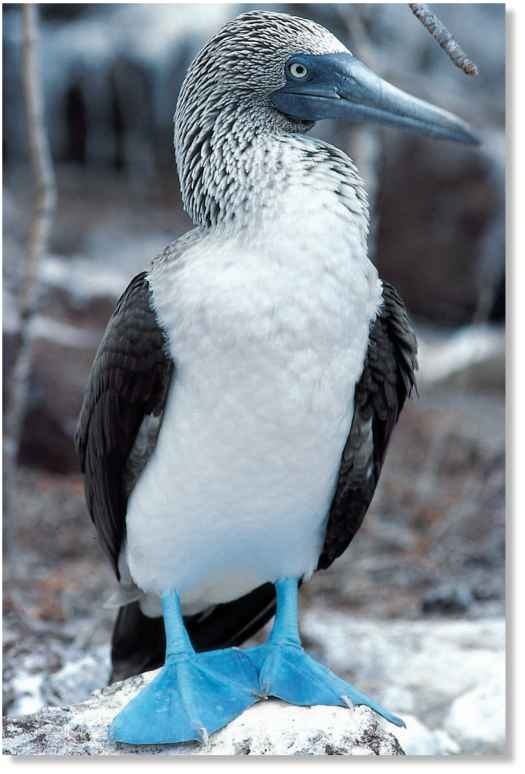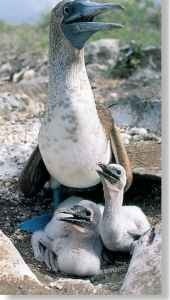ORDER
Pelecaniformes
FAMILY
Sulidae
GENUS & SPECIES
KEY FEATURES
• Plunge-dives into the sea from 100′ above to plunder the abundant shoals of fish found in tropical offshore waters
• Breeding pairs use brightly colored webbed feet and facial skin in ritualized displays and greeting ceremonies
• Highly sociable year ’round, nesting in large colonies and fishing cooperatively in groups of up to 200 birds
WHERE IN THE WORLD?
Coastal and offshore waters of western North and South America, nesting on rocky coasts and islands from Baja California to Peru; an isolated population of about 10,000 pairs nests on Galapagos Islands
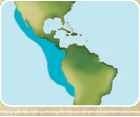
Lifecycle
Diving from the sky with purposeful grace, the blue-footed booby plunges through the surface of the sea and powers along underwater in pursuit of shoals of fish.
HABITAT

A Mass production Breeding colonies have thousands of booby pairs.
Skies above tropical and sub-tropical waters off the western shores of North and South America, from Mexico to Peru, are the domain of the blue-footed booby for nearly all its life. Deep, cold currents flowing north from the Antarctic rise to the surface in this region. These cold upwellings are nutrient-rich and bring plentiful stocks of plankton, fish and squid to the surface — productive feeding grounds for the booby.
Following currents as they change with the seasons, the booby keeps track of waters with the best fish supplies. It comes ashore only to breed on rocky, mainland coastlines or small, barren islets.

A Double on the rocks
Rocky coasts, especially those with steep, bare cliffs, become the booby’s home when it flies ashore to nest.
FOOD & FEEDING
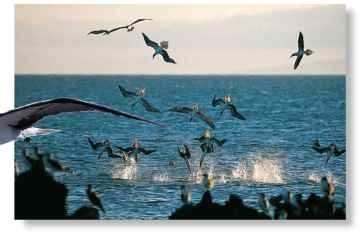
Upwellings of cold currents, such as the Humboldt Current off Peru, yield a rich supply of pilchards, anchovies and sardines: principal food of the booby. Large shoals of these fish fall under repeated “dive-bomb” attack when boobies gather to feed.The blue-footed booby feeds in groups of up to 200 birds, often in the company of flocks of the Peruvian booby (Sula variegata).
Sometimes, the booby feeds cooperatively, with several birds diving together at a given signal — usually a whistle by a male. As the first wave of boobies hits the water, the fish scatter, improving the success rate of the next wave of boobies.
“Booby” comes from the Spanish word bobo, meaning “stupid.” This refers to the birds’ lack of fear, making them easy to catch.
# The blue-footed booby sometimes feeds alongside dolphins, snatching flying fish attempting to flee from the marine mammals.
To cool down in the heat of the day, the booby pants by opening its bill and rapidly vibrating its bare throat skin.
BREEDING
LIGHTNING STRIKE
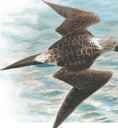
1 Cruise missile…
At 100′ above the sea (twice the height of an average two-story house), a booby identifies a shoal of sardines in the sea below.

2 Lock on…
Plummeting headlong in a steep dive, the booby pulls its wings back parallel to its body before hitting the water.

3 Dive and seek…
Fish scatter as the booby hits the sea. Momentum of its high dive, aided by rapid paddling of its feet, lets it reach a depth of 30′.
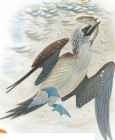
4 Mission over
The booby quickly selects its target and, after a brief pursuit, snatches a fish in its pointed bill and heads for the surface.
Like other seabirds that depend on a food source that’s unpredictable in supply and distribution, the booby adapts its breeding cycle to suit its circumstances. It pairs with a regular mate, but doesn’t nest at the same time each year Apart from food availability the onset of breeding is influenced by the time a pair has spent together and its success rate of rearing young.
When it breeds, the booby gathers in large colonies. Each pair’s crude nest becomes surrounded by sun-hardened white droppings (guano).The booby doesn’t develop brood patches (areas of bare skin on the breast) to warm the eggs during incubation. Instead, it uses the webs of its large feet, which have large numbers of prominent blood vessels, to transmit heat essential for incubation. The eggs are thick-shelled so they can withstand the full weight of an incubating bird. The Bare essentials two eggs hatch after 40
The nest is a simple hollow days and the brood is then scraped out of bare ground. fed for over three months.
BEHAVIOR
The booby is highly sociable, and birds frequently encounter new individuals, especially in dense breeding colonies. The birds use complex displays to show aggression, recognition and friendship.
A range of displays promotes and maintains bonds between mates. When flying toward his incubating mate in a colony a male pushes his brightly colored, blue feet forward for her to see just before he lands. While facing her on the nest, he rocks back and forth, lifting one leg, then the other, to show off the blue webbing of his feet. Other displays
include stretching vertically and y Ballet dancer
turning the head sideways, as a display involves pointing
if avoiding eye contact. the bill up to the sky.
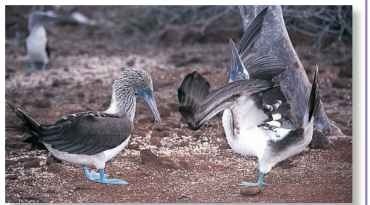
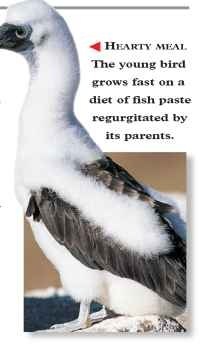
CONSERVATION
The blue-footed booby isn’t under any serious threat, with a stable population of about 100,000 pairs.The Galapagos Islands are home to a tenth of these; this population, while healthy, is vulnerable to predation by feral dogs and cats. Intensive fishing may threaten the booby as fish stocks decline. Already, growing numbers of the birds are becoming fatally entangled in lines and nets while out at sea.
Profile
Blue-footed Booby
A sleekly shaped body and self-sealing nostrils let the blue-footed booby plunge smoothly into the sea to snatch fish in its daggerlike bill.
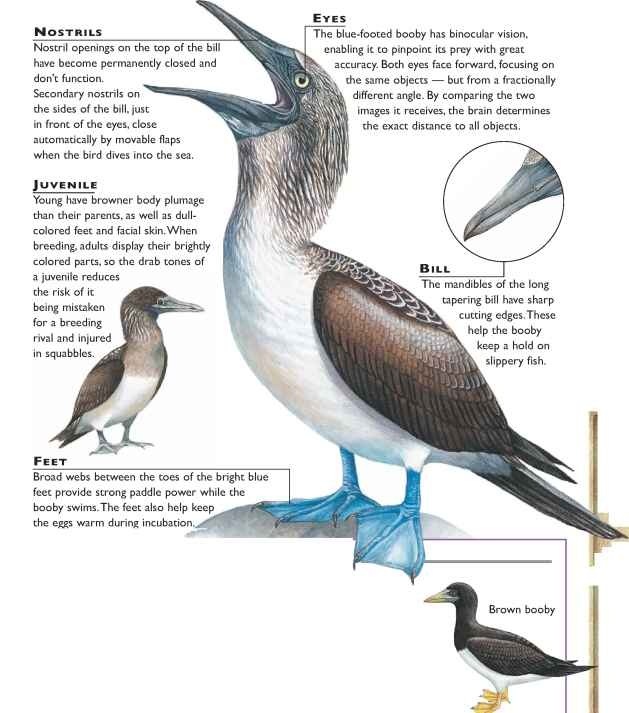
CREATURE COMPARISONS
In northern tropical waters off Baja California, the blue-footed booby is found near the brown booby (Sula leucogaster).The smallest member of its family the brown booby has a straw-colored bill and bright-yellow legs and feet, a striking contrast to its chocolate-brown upperparts. The brown booby occurs widely across the tropical oceans, often nesting and roosting on cliffs or steep slopes. It even perches on outriggers of fishing boats, waiting for a “hand out.” The brown booby performs extensive aerial displays when courting.
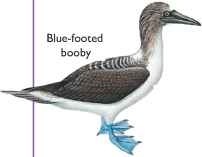
| STATISTICS Weight 2 lbs. |
|
| Length | 2.5-3′ |
| Wingspan | 5′ |
| Sexual Maturity | 2-3 years |
| Breeding 1 Season | Seasonal and opportunistic, depending on food supply |
| Number ! of Eggs | 1-3, usually 2 |
| Incubation Period | 41 days |
| Fledging l Period | 102 days |
| Breeding I Interval | 1 year |
| Typical 1 Diet | Sardines, flying fish, pilchards, mackerel,?,: anchovies |
| Lifespan | 10-20 years |
RELATED SPECIES
• The 9 species in the family Sulidae divide into two groups: 3 gannets in temperate oceans and 6 booby species (all have tropical ranges). Gannets are larger than boobies, with a similar shape and fishing technique. Apart from black wingtips, they’re mainly white. Gannets and boobies are in the Pelecaniformes order, which includes pelicans, frigatebirds and cormorants.
